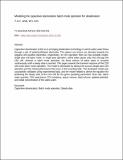| dc.description.abstract | Capacitive deionization (CDI) is an emerging desalination technology in which saline water flows through a pair of polarized/biased electrodes. The cations and anions are attracted towards the negative and positive electrodes, respectively. In CDI operation there are two possible modes: single pass and batch mode. In single pass operation, saline water passes only once through the CDI cell, whereas in batch mode operation, the fixed volume of saline water is recycled continuously until a steady state is reached. This paper presents the transient response of the CDI cell under batch mode operation. The model is developed by taking into account single pass CDI operation and the mixing phenomena that occur in the recycling tank. The developed model was successfully validated using experimental data, and the model helped to derive the equation for predicting the steady state of the CDI cell for the given operating parameters: flow rate, saline water quantity, CDI capacitance, CDI resistance, spacer volume, dead volume, applied potential, and initial concentration of the saline water. | en_US |

